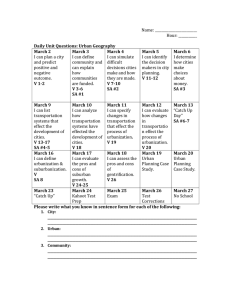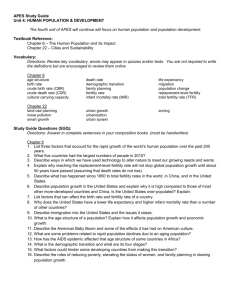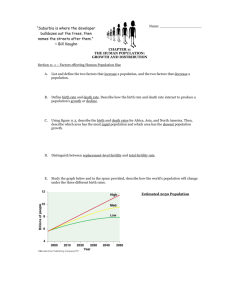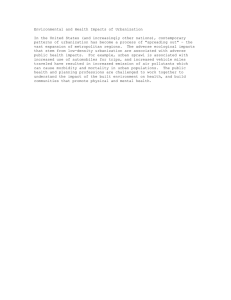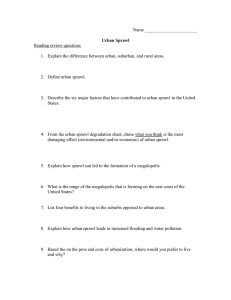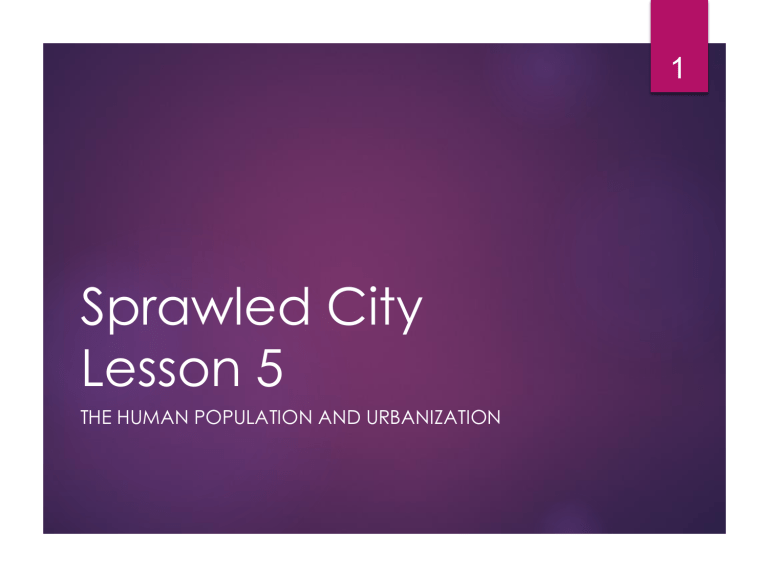
1 Sprawled City Lesson 5 THE HUMAN POPULATION AND URBANIZATION How Many People Can the Earth Support? 2 Human Population Growth Continues But it is Unevenly Distributed For most of history, the human population grew slowly, but has been growing exponentially for the past 200 years. Reasons for this increase in growth rate include: Humans have expanded into almost all of the planet’s climate zones and habitats. The emergence of early and modern agriculture allowed us to grow more food for each unit of land area farmed. Death rates dropped sharply because of improved sanitation and health care. 3 Human Population Growth Continues But it is Unevenly Distributed 4 The rate of population growth has slowed, but the world’s population is still growing at a rate that added about 83 million people during 2011. Geographically, growth is unevenly distributed. About 1% of the 83 million new arrivals on the planet in 2011 were added to the world’s more-developed countries The other 99% were added to the world’s middle- and lowincome, less-developed countries. At least 95% of the 2.6 billion people likely to be added to the world’s population between 2011 and 2050 will end up in the least-developed countries. Average annual global growth rate (percent) 2.5 5 2.0 1.5 1.0 0.5 0.0 1950 1970 1990 2010 Year 2030 2050 Human Population Growth Continues but it is Unevenly Distributed 6 Cultural carrying capacity is the maximum number of people who could live in reasonable freedom and comfort indefinitely, without decreasing the ability of the earth to sustain future generations. What Factors Influence the Size of the Human Population? 7 The Human Population Can Grow, Decline, Or Remain Fairly Stable Birth rate, or crude birth rate, is the number of live births per 1,000 people in a population in a given year. Death rate, or crude death rate, is the number of deaths per 1,000 people in a population in a given year. Population change of an area = (births + immigration) - (deaths + emigration) 8 Women are Having Fewer Babies but not Few Enough to Stabilize the World’s Population The total fertility rate (TFR) is the average number of children born to women in a population during their reproductive years. Between 1955 and 2011, the average global lifetime number of births of live babies per woman dropped from 5 to 2.5. A TFR of 2.1 will eventually halt the world’s population growth. 9 Several Factors Affect Birth Rates and Fertility Rates A particular country’s average birth rate and TFR can be affected by: The importance of children as a part of the labor force. The cost of raising and educating children. The availability of, or lack of, private and public pension systems. Urbanization. 10 Several Factors Affect Birth Rates and Fertility Rates The educational and employment opportunities available for women. The average age at marriage. The availability of legal abortions. The availability of reliable birth control methods. Religious beliefs, traditions, and cultural norms. 11 Migration Affects an Area’s Population Size Migration is the movement of people into (immigration) and out of (emigration) specific geographic areas. Most people who migrate from one country to another are seeking jobs. Religious persecution, ethnic conflicts, political oppression, wars, and certain types of environmental degradation are also factors. Environmental refugees are people who migrate due to environmental degradation such as soil erosion and water and food shortages. One UN study estimated that a million people are added to this category every year. 12 How Does a Population’s Age Structure Affect Its Growth or Decline? 13 A Population’s Age Structure Helps Us to Make Projections 14 Age structure is the numbers or percentages of males and females in young, middle, and older age groups in a given population. Population age-structure diagrams are made by plotting the percentages or numbers of males and females in the total population in each of three age categories: Prereproductive (0–14): normally too young to have children. Reproductive (15–44): normally able to have children. Postreproductive (45+): normally too old to have children. A Population’s Age Structure Helps Us to Make Projections 15 Demographic momentum is rapid population growth in a country that has a large percentage of people younger than 15, and happens when a large number of girls enter their prime reproductive years. 1.8 billion people will move into their reproductive years by 2025. Most future human population growth will take place in lessdeveloped countries due to their population age structure. The global population of seniors (age 65 and older) is increasing due to declining birth rates and medical advances that have extended life spans. How Can We Slow Human Population Growth? 16 There are Three Effective Ways to Slow Population Growth The three most effective ways to slow or stop population growth are: Reduce poverty Elevate the status of women Encourage family planning and reproductive health care. 17 Birth rate and death rate (number per 1,000 per year) Stage 1 Preindustrial 80 70 60 50 Population grows very slowly because of a high birth rate (to compensate for high infant mortality) and a high death rate Stage 2 Transitional Stage 3 Industrial Population grows rapidly because birth rates are high and death rates drop because of improved food production and health Total population Birth rate 40 Population growth slows as both birth and death rates drop because of improved 18 Stage 4 Postindustrial Population growth levels off and then declines as birth rates equal and then fall below death rates food production, health, and education 30 Death rate 20 10 0 Low Increasing Very high Decreasing Growth rate over time Low Zero Negative Promote Economic Development As countries become industrialized and economically developed, their populations tend to grow more slowly. This demographic transition has four phases: Preindustrial Transitional Industrial Postindustrial 19 Promote Economic Development Less-developed countries may transition to slower growth if modern technology can raise per capita incomes by bringing economic development and family planning. Rapid population growth, extreme poverty, and increasing environmental degradation in some low-income less-developed countries— especially in Africa—could leave these countries stuck in stage 2 of the demographic transition. 20 Empowering Women Can Slow Population Growth Women tend to have fewer children if they are educated, have the ability to control their own fertility, hold a paying job outside the home, and live in societies that do not suppress their rights. Women account for 66% of all hours worked but receive only 10% of the world’s income and own just 2% of the world’s land. Women make up 70% of the world’s poor and 64% of its 800 million illiterate adults. Poor women who cannot read often have an average of 5–7 children, compared to 2 or fewer children in societies where almost all women can read. 21 22 Promote Family Planning Family planning provides educational and clinical services that help couples choose how many children to have and when to have them. Successes of family planning: Without family planning programs that began in the 1970s, the world’s population would be about 8.5 billion instead of the current 7 billion. Family planning has reduced the number of abortions performed each year and decreased the numbers of mothers and fetuses dying during pregnancy. 23 Promote Family Planning Problems that have hindered success in some countries: 42% of all pregnancies in less-developed countries are unplanned and 26% end with abortion. An estimated 201 million couples in lessdeveloped countries want to limit their number of children, but lack access to family planning services. What are the Major Urban Resource and Environmental Problems? 24 Scientists See Three Important Urban Trends 25 An increasing percentage of the world’s people live in urban areas. Urban areas grow in two ways—by natural increase due to births and by immigration, mostly from rural areas. Three major trends in urban population dynamics have emerged: The proportion of the global population living in urban areas increased from 2% in 1850 to 50% today, and is projected to be 70% by 2050. Scientists See Three Important Urban Trends 26 The numbers and sizes of urban areas are mushrooming. We now have cities with 10 million or more people (megacities or megalopolises) and will soon have hypercities with more than 20 million people. Megacities and hypercities are merging into megaregions that can stretch across entire countries. Poverty is becoming increasingly urbanized, mostly in lessdeveloped countries. An estimated 1 billion people in lessdeveloped countries live in urban slums and shantytowns. Urban Sprawl Gobbles Up the Countryside Urban sprawl, or the growth of low-density development on the edges of cities and towns, is eliminating surrounding agricultural and wild lands. Urban sprawl is the product of affordable land, automobiles, relatively cheap gasoline, and poor urban planning. 27 Urban Sprawl Gobbles Up the Countryside Urban sprawl has caused or contributed to a number of environmental problems. People are forced to drive everywhere, resulting in more emission of greenhouse gases and air pollution. Sprawl has decreased energy efficiency, increased traffic congestion, and destroyed prime cropland, forests, and wetlands. Sprawl has led to the economic deaths of many central cities as people and businesses move out. 28 29 Urban Sprawl 30 Urbanization Has Advantages Cities are centers of industry, commerce, transportation, innovation, education, technological advances, and jobs. Urban residents in many parts of the world tend to live longer than do rural residents, and have lower infant mortality and fertility rates. Cities provide better access to medical care, family planning, education, and social services. Recycling is more economically feasible. Concentrating people in cities helps to preserve biodiversity. Central cities can save energy if residents rely more on energy efficient mass transportation, walking, and bicycling. 31 Urbanization Has Disadvantages Most urban areas are unsustainable systems. The typical city depends on large non-urban areas for huge inputs of matter and energy resources, while it generates large outputs of waste matter and heat. Most cities lack vegetation. Destroyed vegetation could have absorbed air pollutants, given off oxygen, provided shade, reduced soil erosion, provided wildlife habitats, and offered aesthetic pleasure. Many cities have water problems. Providing water to cities can deprive rural and wild areas of surface water and can deplete underground water supplies. 32 Urbanization Has Disadvantages Cities in arid areas that depend on water withdrawn from rivers and reservoirs behind dams will face increasing problems. Cities can have flooding problems for several reasons: Being built on floodplains or near low-lying coastlines. Covering land with buildings, asphalt, and concrete causes precipitation to run off quickly and overload storm drains. 33 Urbanization Has Disadvantages Destroying or degraded large areas of wetlands that have served as natural sponges to help absorb excess storm water. Flooding as sea levels rise because of projected climate. Cities in arid areas that depend on water bodies fed by mountaintop glaciers will face water shortages if global warming melts the glaciers. 34 Urban Areas are Rarely Sustainable Systems 35 Inputs Energy Food Water Outputs Solid wastes Waste heat Air pollutants Water pollutants Raw materials Manufactured goods Money Information Greenhouse gases Manufactured goods Noise Wealth Ideas Fig. 6-18, p. 110 36 Cities Tend to Concentrate Pollution And Health Problems Cities produce most of the world’s air pollution, water pollution, and solid and hazardous wastes. High population densities can increase the spread of infectious diseases, especially if adequate drinking water and sewage systems are not available. 37 Cities Affect Local Climates Cities tend to be warmer, rainier, foggier, and cloudier. Heat generated by cars, factories, furnaces, lights, air conditioners, and heat-absorbing dark roofs and streets creates an urban heat island surrounded by cooler suburban and rural areas. The artificial light created by cities affects some plant and animal species. Life is a Desperate Struggle For the Urban Poor in LessDeveloped Countries At least 1 billion people live under crowded and unsanitary conditions in cities in lessdeveloped countries. Slums are areas dominated by tenements and rooming houses where several people might live in a single room. Squatter settlements and shantytowns are on the outskirts of cities, and usually lack clean water supplies, sewers, electricity, and roads, and are subject to severe air and water pollution and hazardous wastes from nearby factories. 38 How Does Transportation Affect Urban Environmental Impacts? 39 Motor Vehicles Have Advantages And Disadvantages They provide mobility and offer convenient and comfortable transportation. They can be symbols of power, sex appeal, social status, and success. Much of the world’s economy is built on producing motor vehicles and supplying fuel, roads, services, and repairs for them. Globally, automobile accidents kill approximately 1.2 million people a year and injure another 15 million people. 40 41 Reducing Automobile Use is not Easy, But it Can Be Done Raise parking fees and charge tolls on roads, tunnels, and bridges leading into cities, especially during peak traffic times. Some cities promote car-sharing networks, which bill members monthly for the time they use a car and the distance they travel, and can decrease car ownership. Some Cities Promote Alternatives To Cars The following are alternatives to cars, each with its own advantages and disadvantages: Bicycles Mass-transit rail systems in urban areas Bus systems in urban areas High-speed rail systems between urban areas (bullet trains) 42 How Can Cities Become More Sustainable and Livable? 43 We Can Make Urban Areas More Environmentally Sustainable and Enjoyable Places To Live Smart growth encourages environmentally sustainable development requiring less dependence on cars, controls and directs sprawl, and reduces wasteful resource use, by using zoning laws and other tools to channel growth into areas where it can cause less harm. New urbanism involves less-developed villages within cities, so that people can live within walking distance of where the work, shop, and go for entertainment 44 45 Three Big Ideas The human population is increasing rapidly and may soon bump up against environmental limits. We can slow human population growth by reducing poverty, encouraging family planning, and elevating the status of women. Most urban areas are unsustainable, but they can be made more sustainable and livable within your lifetime. 46 Thank You!
